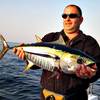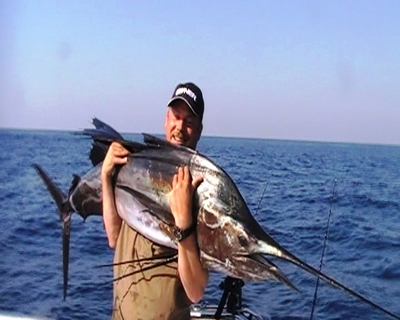June 16th 2008 was a lovely Durban winters morning, it was warm, the sun was shining, the skies were clear and the wind was a mere breeze. The seas were flat and the water crystal clear. Further down south from Durban there had been the recent devastating floods which had put an end to the very promising 2008 annual sardine run, and yet there was no evidence of any devastation with such a perfect day. It was just Lionel Crow and I on the Nikao Fishing Adventures Boat and we had snuck out for a midweek fishing quickie.
We started out the day just south of Durban and had been collecting live mackerel for bait; we then took the boat only about one nautical mile out slightly south of the old whaling station and proceeded to prepare our live baits.
I then cast out my live bait and as it hit the water there was a big splash and the line went tight and I picked up the rod to strike but I hesitated as this do not feel like any fish I had ever caught before and I could not quite make out what to do and so I just started retrieving as not line was being taken. After about 30 40 seconds it became evident what we had on. It was a greedy gannet and it had my hook right through the "elbow" part of its wing. Not wanting to hurt the bird we reeled all lines in and I proceeded to slowly and carefully bring him in. Eventually we got him to the boat and had to distract him with the boga grip so we could grab him behind the head to prevent that sharp beak from inflicting revenge on us. Once we got the angry gannet onto the boat and it realized we were not hurting it but actually trying to help him, even after it stole our mackerel, it settled down and allowed us to cut the hook and remove it. Once this was done we ensured that the bleeding was not bad and we let it fly. We did not see the bird again after that episode.
We then started out the whole procedure again getting our live baits out. I was still rigging my mackerel when Lionel cast out his mackerel and as it hit the water there was a splash again. We both thought Gannet, but when the reel started screaming we realised it was something much bigger and then we saw a Saily jump clear out the water not far from the boat we knew the fight was on as the Saily was the size of a small Marlin. At his point I grabbed the video camera and started recording and by the time I had it all working the Saily was already about 300m from the boat, and so the fight began and the little Diawa reel was starting to run out of line and we had to follow the Saily with the boat. We got him close to the boat and as soon as he saw the boat he was off for another 300m plus and we again had to follow him and this happened three more times. On the second to last time we got him to the boat he we right around the boat and then went deep, but eventually one hour fifteen minutes later we got the boga grip attached to him and brought him onto the boat.
It was a heavy fish and the two of us struggled to lift it out of the water without hurting it, but we did it. I then videoed Lionel holding the fish and he was struggling to hold it and nearly fell overboard with the fish wrapped up in his arms as if it was his first love. He had a smile wider than the length of the fish and there was absolutely nothing you could do or say to him that could wipe it off his face. (Actually the smile lasted for more than a week).
We then measured the fish from the lower bill to the fork in the tail and it was 3.57m long, we were not able to weigh the fish as the scale we had only went up to 30Kg.
According to Rudy Van Der Eslt's "A Common Guide to Sea fishes of Southern Africa" a Sailfish (isyiophorus platypterus) can attain a maximum of 3.0m and so this Saily was as big as they get and according to his chart would have had a weight of around 70Kg, but as I mentioned we could not weigh it. Also according to this book the current SA angling record is 64.9Kg which makes this Saily at least 5Kg over the current SA record.
Both Lionel and I are avid supporters of catch and release and without even discussing the matter we both proceeded to gently ease this graceful giant of the deep back into the water (who cares about an official record, we know what we got and it is on video) and we then ran the one motor slowly an helped this fantastic animal to revive itself. After fifteen minutes the Saily made a graceful bow and disappeared into the deep to live another day. We were happy, we were proud, we were ecstatic as we new we had got a trophy which most likely will never be repeated in our lifetimes, but we have a memory that we can keep with us through to our golden years, and it is a good memory because the Saily lived on.
The tackle used was a little Daiwa Sealine SL20H Reel, Spooled with Suffix 24lb Line and a 50Lb Flouro carbon leader on an Owner 5/0 Game Hook. The hook was just pushed through the upper jaw section of the live mackerel that was used as bait. This is a very simple rig, but it is good for catching several species like Dorado, Tuna, large Bonnies and even Couta who all love live or even dead mackerel. Ideally for Couta you would want a wire trace. It is best fished on the drift as a trap stick whilst you are jigging and so on.
Off Durban we catch the mackerel on small yozuri's type lures, and they are plenty full in the shallower waters around Durban. There are 2 x of mackerel that we get which is the Common mackerel (scomber japonicus) which is the one we used and the one I have found the game fish to prefer and then there is the Sugar mackerel (rastrelliger kanagurta) which does not get the same amount of hits. Another favorite of game fish is the maasbanker (trachurus trachurus) also known as horse mackerel. Small live striped bonitos or eastern little tuna can also be rigged in the same way with great effect and even red eye sardine if you ca keep them alive long enough to get them rigged.
It shocks me to see guys killing Sailfish just for their egos so they can get to show someone or make a trophy. Please guys take a photo and put them back, you will earn far more respect that way, and if you think that showing your face in a photo with a fish like this that you killed is going to earn you respect, you are wrong those days are gone. I can proudly say that in more than 30yrs of fishing I have never killed a Billfish.
We really need to start making an effort to preserve our resources and learn how to handle these fish photograph them and release them. If you need a trophy it is as easy as taking your measurement on a photo to prove them and photos of the fish and any unique markings or scars and there are many taxidermists who will make your trophy without the need to kill the fish. Look after what we have left, so our children and grand children can also see these creatures and not just read about them. One person can make a difference.



